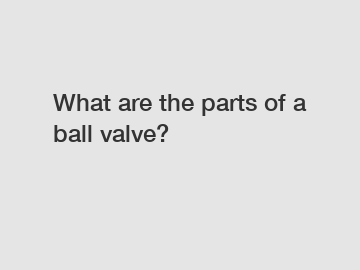What are the parts of a ball valve?
What are the parts of a ball valve?
Ball valves play an essential role in controlling and regulating the flow of various fluids or gases in industrial processes. They are used in a wide range of applications, including oil and gas pipelines, water management systems, and manufacturing industries. Understanding the different parts of a ball valve is crucial to comprehend its functionality and maintenance requirements. Let's delve into the various components that make up a ball valve and how they contribute to its overall operation.
1. Body:

The body of a ball valve serves as the primary structure that houses all the internal components. It is designed to withstand high pressure and is typically made from materials such as stainless steel, brass, or cast iron. The body also features flanges or threaded ends, allowing for easy installation and connection with pipelines.
2. Ball:
The ball is the most critical component of a ball valve and is responsible for controlling the flow. It is typically made from brass, stainless steel, or a combination of materials based on the application requirements. The spherical shape of the ball allows for efficient flow control by rotating it to open or close the valve. When the ball is rotated 90 degrees, the flow is completely shut off. The quality of the ball is paramount as it ensures the valve's performance and durability.
3. Stem:
The stem connects the ball to the actuator, allowing for the rotational movement of the ball. It transmits the motion from the actuator to the ball, enabling the valve's operation. The stem is usually made from stainless steel or brass and must be properly lubricated to minimize friction and ensure smooth movement.
4. Seats:
Seats are the sealing surfaces located within the body that provide a tight seal when the ball is in the closed position. They prevent any leakage when the valve is shut off, ensuring the system's safety and efficiency. Seats are typically made from materials such as PTFE (polytetrafluoroethylene) or other resilient materials that can handle various temperatures and pressures.
5. Actuator:
The actuator is the mechanism responsible for moving the ball within the valve. There are several types of actuators, including manual hand levers, pneumatic actuators, and electric or hydraulic motors. Manual actuators are manually operated, while automated actuators use external signals or power sources to control the valve's movement. The actuator plays a vital role in controlling the flow rate or shutting off the valve based on the system's demands.
To conclude, understanding the different parts of a ball valve is crucial for anyone involved in industries that rely on fluid or gas control. The body, ball, stem, seats, and actuator work together to ensure efficient and precise operation. Proper maintenance and regular inspection of these components are essential to ensure the valve's longevity and prevent any leakage or operational issues. Next time you encounter a ball valve, remember to check its parts and appreciate their significance in the overall functionality of the valve.
Contact us to discuss your requirements of Customized Stainless Steel Castings, Oem Stainless Steel Investment Precision Castings, Camlock Handle Ring. Our experienced sales team can help you identify the options that best suit your needs.
143
0
0


Comments
All Comments (0)